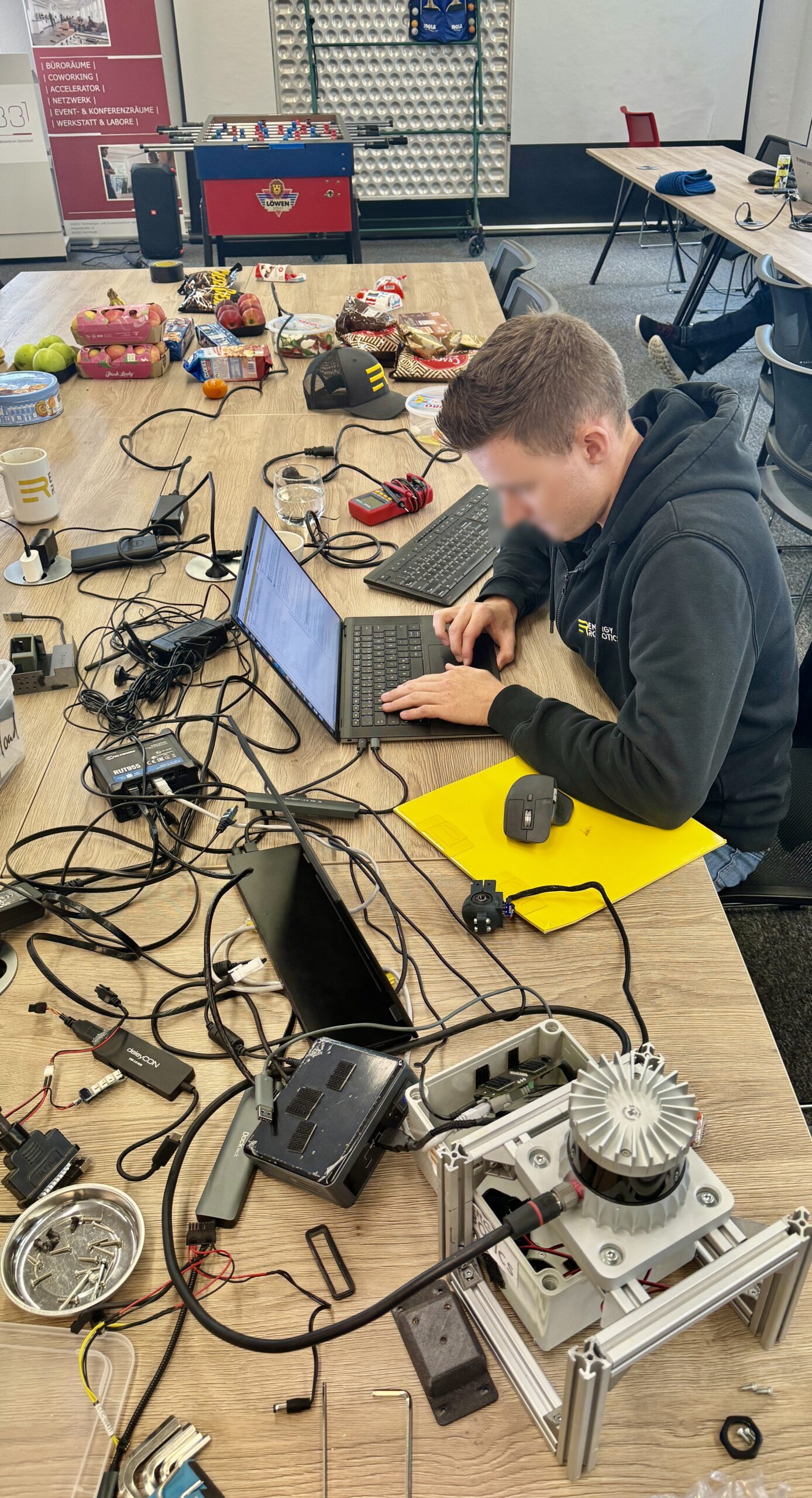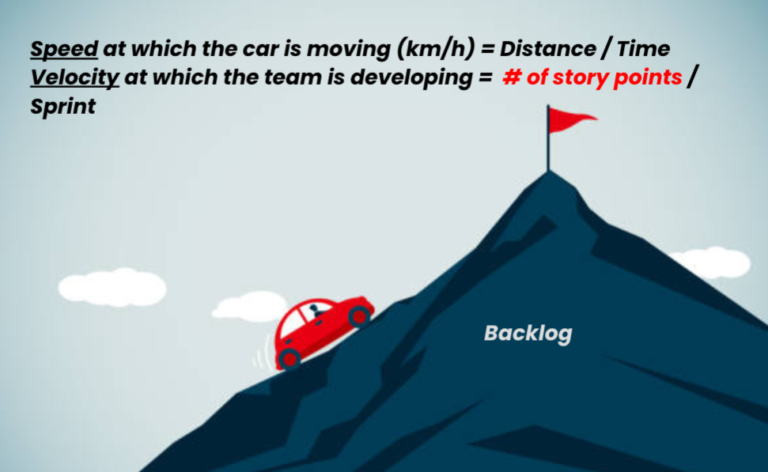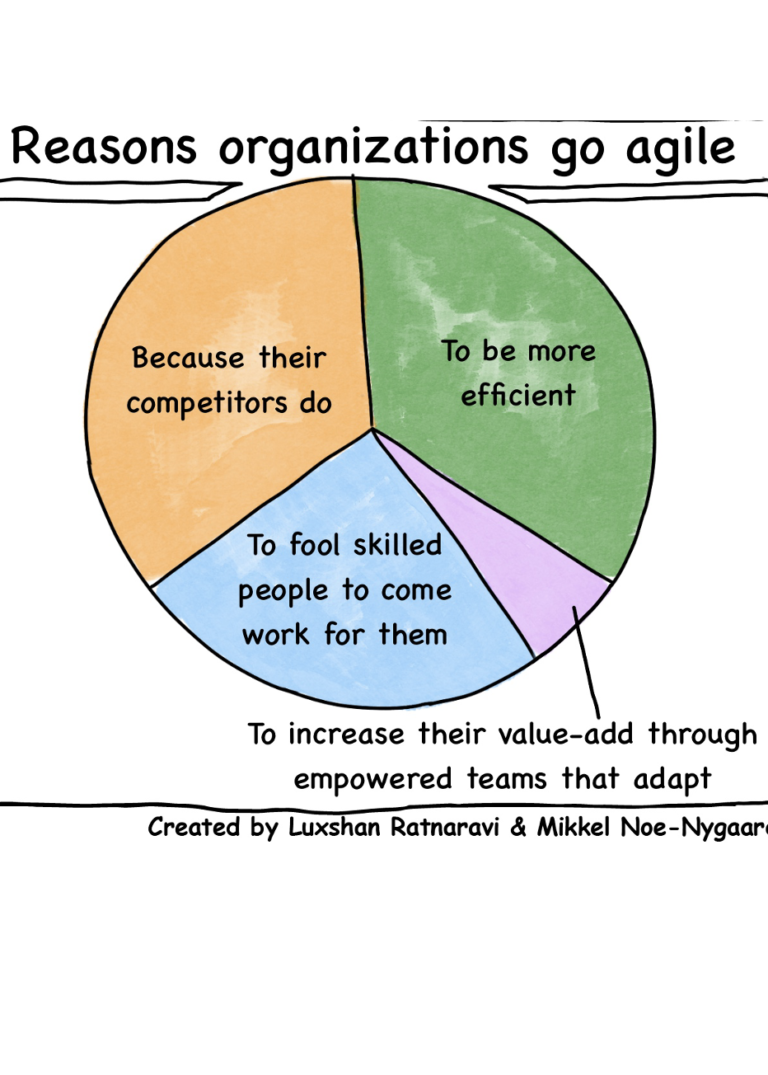How To Organise A Hackathon?
How To Organise A Hackathon?
During a hackathon, people collaborate intensively to solve a specific problem in a short time frame. The goal is to create a high-quality and innovative solution to a problem. But how to organise a hackathon? Where to start? Look no further! This article will provide you with a complete guide, examples, and recommendations.
Why would you organise a hackathon?
Hackathon provides a space for learning, sharing ideas, networking, and fostering innovation. The term “hackathon” is a combination of “hack”, referring to exploratory programming, and “marathon”. So you get the gist – it is a fast hack to a problem.
However, a hackathon can also provide a creative break from the daily routines for your team members while dedicating time to something completely new and innovative. A hackathon is a routine breaker. All the tedious corporate processes, policies, and limitations can be paused. Even the organisational structure of your company is put on pause because hackathon teams are new teams – mixing up the hierarchies and structures everyone’s used to. Almost like in a medieval carnival where royals mixed with peasants – in a hackathon bosses mix inside the teams with interns, newbies and create something new. 🙂
In my current company, we decided to organise a hackathon primarily to spark innovation, to get out of the routine and supercharge the team spirit. Now – a week after the hackathon – I’m glad to report that we overachieved all of those goals by 200%.
To organise a hackathon – one needs to consider and plan for several important aspects: timing, agenda, rules, evaluation of ideas, and many other organisational matters. I will give my take on each one of those from the experience of a recent hackathon. But you can surely twist and improve every approach to suit your specific needs!
Timing and agenda
The length of a hackathon is by definition short – normally, from 2 to 3 days…and nights of work. Yes, even though working at night is not encouraged, the teams usually want to tap into the precious sleep time and work continues in late hours or even throughout the night. It’s good to start a hackathon early in the week – e.g. on Monday or Tuesday – when people are fresh and full of energy. While remote hackathons exist, it is still best done in person, therefore, you have to allow time for travel and co-location if you are a distributed team like ours.
In the recent hackathon, we started on Monday around lunchtime. People could travel in on Monday morning until lunch and after lunchtime, we kicked off the hackathon with the pitching of ideas and creating the teams. In this way the work could start already on late Monday afternoon; on Tuesday and Wednesday we continued with ‘hacking’ and the team demos were scheduled for Thursday morning. So in total, our hackathon was 2.5 days (and 3 nights) which seemed quite optimal to come up with high-quality demos.
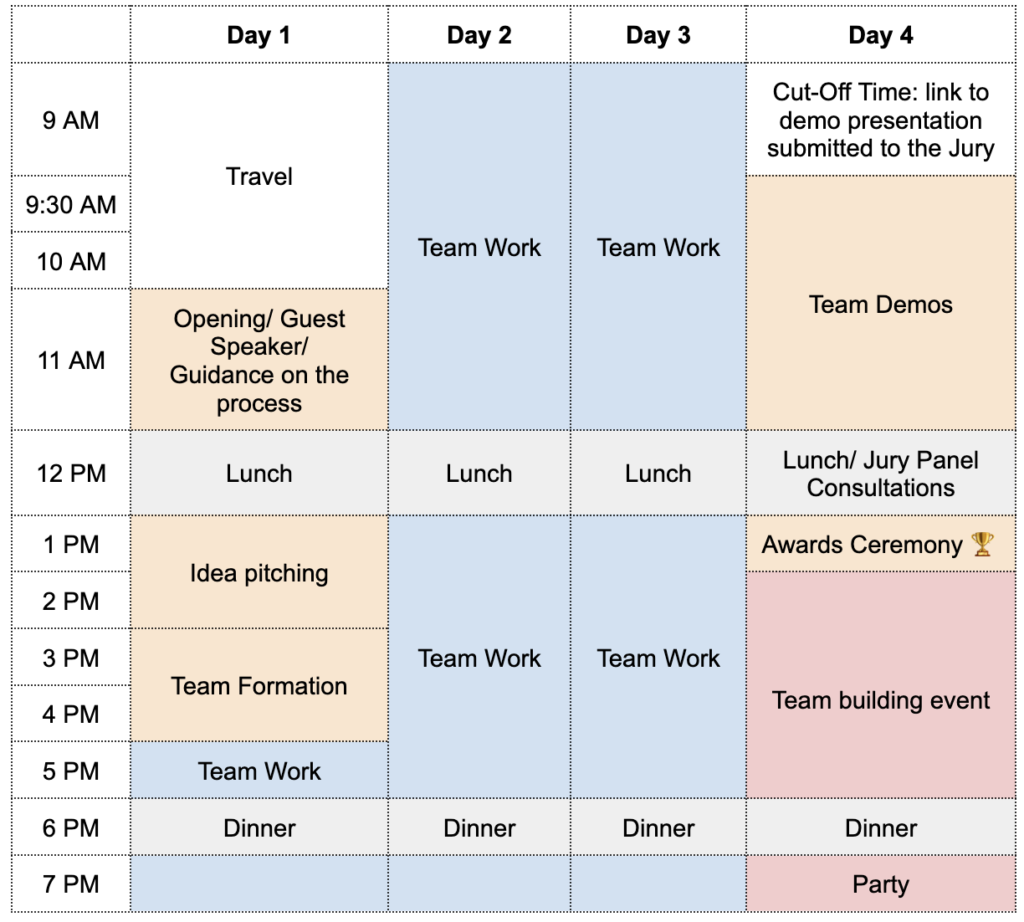
The frequency of hackathons varies between companies. Some do it as a one-off event to boost motivation, and others do it very frequently (e.g. quarterly) – to source new ideas for product features. In our company, the current thinking is that we should do the hackathon annually as a company-wide event. We have no shortage of ideas and innovation happening in our daily business, therefore, a more frequent cadence would be a stretch of our time (and budget).
Themes, ideas & teams
Hackathons usually have pre-defined and specific themes. The purpose of a theme is to provide the direction for ideas that people will work on during a hackathon. The hackathon theme can range from quite general to very narrow and specific. If you run a hackathon infrequently – you may want to choose a more generic theme, for example, “Hot sh*t that we always wanted to have” (actually, the theme of our latest hackathon!); whereas, if you run hackathons regularly – each hackathon can be dedicated to a very narrow topic (e.g. AI, customer success, accessibility, etc.).
The ideas for a hackathon are sourced from the employees themselves. That is an essential property of a hackathon – people decide on the ideas that they want to work on. The submission of the ideas can be done before the hackathon – this is the approach we took last time. It provides the hackathon org team leverage to match the number of ideas with the number of participants. For example, we polled the entire team (vote on a scale of 1-10) on ‘Which of the submitted ideas do you want to see being worked on during the hackathon?’; in this way, we narrowed down the list of ideas to 8-10. Alternatively, one could choose to skip the idea submission phase before the hackathon and leave it to the beginning – anyone who has an idea can pitch it at the beginning of the hackathon. The risk is that the number of ideas will exceed the availability of people (in our case) and pitching of all of them will take more than a day. If the number of ideas is manageable – all of them could potentially be pitched at the beginning of the hackathon.
The idea of pitching, however, is a step that should not be skipped. Some hackathons allow for the ideas to be pitched online over a video call or in pre-recorded pitches – this allows for remote team members to start grouping themselves into hackathon teams before co-locating for the event. It is an ‘ok’ solution, however, live pitching is preferred because of the discussion and Q&A that naturally evolves after each pitch and all ideas have more equal grounds for presentation. Pitching should be prepared – it’s best to provide (and remind about) detailed guidance on how to prepare the pitches and give the idea authors time to prepare (you can see my guidance on pitching here). Each pitch and the following questions after the pitch should be time-boxed (I use stagetimer.io for that) to ensure equity and brevity (we gave 3 minutes per pitch + 2 minutes for Q&A).
How do you create teams from ideas? This might seem like a daunting task, however, luckily people are excellent at it as long as you provide the right guidance. First, one should create a collaboration page where people can put up their names for the one team they are interested in joining. Second, you have to give time for people to ‘shop around’ – talk to different team leaders after their pitches – so that they can better determine which team they are interested in; it is like a marketplace of ideas and teams where people stroll around and pick the one they like. Last but not least – you have to set clear rules for team creation, for example, “By 4 pm everyone should find a team to join!” and then – watch the magic happen. Some refinement might be needed if nobody wants to join one team but everybody wants to join another – do this calibration openly by facilitating an honest and transparent conversation, explaining that we want to round up the teams, and inviting people to distribute themselves along the list of available teams evenly.
Team structure can be left unregulated, however, my recommendation is to establish some rules around how the teams should look. In our late hackathon, we had rather strict rules from the outset: the team should consist of 2-5 people with at least 1 member from the ‘business’ side of the company. We wanted to have small and nimble teams – more teams and ideas to choose from – therefore, we opted for more but smaller teams. We intended to involve the entire company in the hackathon (not just engineers) and 4:1 was roughly the ratio between tech and business people in our company. However, during the team formation process, we had to relax the rules a little bit – allowing 6-member teams and some teams without any ‘business’ people just because some ideas were very popular and we had a shortage of ‘business’ people in the room. Alternatively, some larger companies tend to organise hackathons only for the ‘tech’ part of the company. That is also fine – as long as the objectives and target audience are clear. Nevertheless, Involving everyone in a hackathon promotes multi-disciplinary thinking, diversity, and inclusion. I’m happy that we managed to prove that it is not only possible to organise a hackathon for the entire company but also beneficial – involving ‘non-tech’ people in the hackathon provides a massive value added because people from business contribute to the sense checking of the ideas, they are often close to the customers and can validate the different hypothesis, as well as they are very good at explaining and selling ideas in a simple language to the jury when the demo time comes.
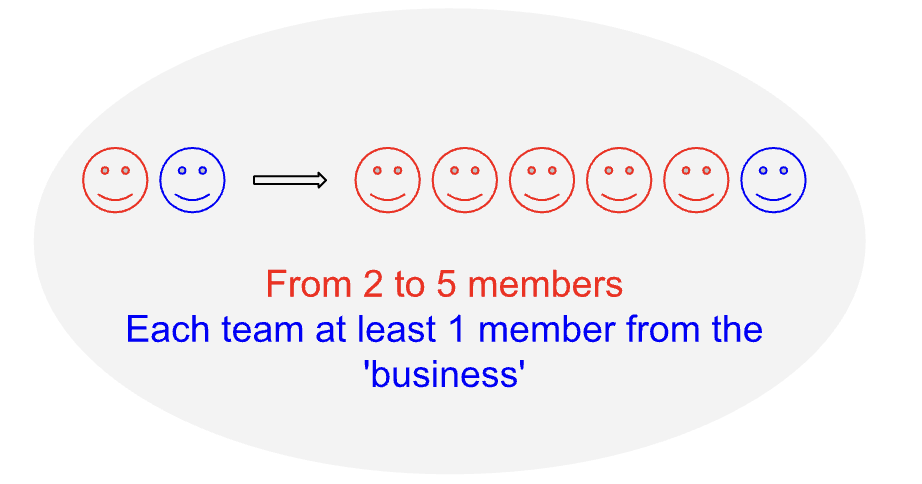
Advisors & mentors
Sometimes when mixing up the teams for a hackathon – the resulting teams may lack some specific competence. It is important to think before the hackathon – which specific areas may pose bottlenecks – where will all the teams seek help? – It is necessary to establish groups of expert advisors from those domains (an idea I borrowed from Scoro) and make them available during the hackathon for consultations.
Before our hackathon, we identified that frontend, backend, AI, and DevOps/Infra are 4 areas where our teams may seek an extra hand. I reached out to experts in those domains and agreed with them to reserve max 2 hours per day to consult other teams outside their own during the hackathon. We established chat channels for teams to request help directly from the advisory groups and published all the information and guidance on using the advisors in advance.

Another extra in a hackathon is mentors – those are senior executives in the company who are all tasked to be available during the hackathon for any team to reach out for mentorship. The role of mentors involves providing the following:
- Guidance and Support: Mentors provide guidance and support to participating teams throughout the hackathon. They can help teams turn ideas into tangible solutions.
- Motivation and Fresh Ideas: Mentors motivate participants and assist them in generating fresh ideas for their solutions. They encourage creativity and experimentation.
- Advice and Know-How: Mentors help teams by guiding knowledge resources, tutorials, and documents.
- Focus and Goal Alignment: Mentors keep teams focused on their end goals as well as align those goals with the Hackathon objectives and evaluation criteria.
Naturally, all the executives have to be contacted before the hackathon and briefed about their roles and responsibilities as mentors. At the same time, mentors can also participate in the hackathon teams if they choose to do so. Most of our executive team in the latest hackathon joined the hackathon teams, while, their mentorship was appreciated at the beginning by many teams seeking guidance and feedback on the initial ideas.
Demos, evaluation & prizes
A hackathon is a competition. The teams work to create a solution that they can demo in a very short timeframe and their demo is assessed and evaluated. The best team is determined. My recommendation is to leave plenty of time for team demos. You want to time-box each demo so that the competition is fair (we used 5-minute slots). However, you want the teams to have high-quality demos, therefore, do guide them on how to create a great demo (see my recommendations here)! You may publish specific guidance or go around the teams and challenge them to think about their demos. Regardless of how hard the team worked during the hackathon if the demo is weak – it will not succeed. Allow each team plenty of time to set up their demo, use a stage, use microphones for added presentation effect, and allow the teams to connect their laptops to the projector to present stuff (and avoid being blamed if your laptop fails to display the correct font in their presentation). Encourage live demos – showing the real thing, instead of slides or pre-recorded content. Encourage the teams to engage with the jury and the audience. Great demos are memorable – everyone will judge only the demos and they will determine the success or failure of the teams.
Since a hackathon is a competition – the teams have to be evaluated in some way. There are multiple approaches for doing that. One is to set up a jury that will decide on the winner. The jury often includes the CEO of a company and other senior executives. But in the best-case scenarios jury also involves external members – customers of the company. Adding your customers (or users) to the jury has many benefits – you get alternative and very much user-centric perspective (and questions) from the jury, as well as you can later learn a lot about your customers from their voting behaviour in the jury. An added benefit is that you can impress the customers with your team and the level of innovation during hackathon that often exceeds the innovation level of the daily business.
In our latest hackathon employees suggested that they also want to take part in deciding on the hackathon winners. Not only did they want to have a say – they suggested that the weight of the jury vote should be reduced to 25% and the employee vote would have the rest – 75% weight in the final result. Needless to say, it complicated the voting process, however, we found a mathematical and technical solution for this. The jury voted according to detailed evaluation criteria (with pre-defined weights – see below), but the employees voted using a survey – assessing each demo on a scale of 1-10. The jury and employee votes were both normalised (divided by the maximum possible points) and then the 25% and 75% weights were applied to determine the winners (download here the evaluation template). Such a complex voting process is not required if everyone is ok with the jury deciding on the winners, however, we managed to establish a voting mechanism that provided all employees with a significant say in the final result.
If you consider using a jury to evaluate the hackathon demos – it is a good idea to craft very detailed evaluation criteria and provide guidance and explanations to the jury. We opted for 5 evaluation criteria and assigned a specific weight to each of the criteria as outlined in the next table. Note that the weight of the criteria can imply what you expect from the demos – where do you see more value? For example, we allocated a significant weight to the value of the solutions but also gave large weight to the innovativeness and demo quality – because we expected the teams to come up with novel solutions and prepare to sell their solutions in the demos very well.
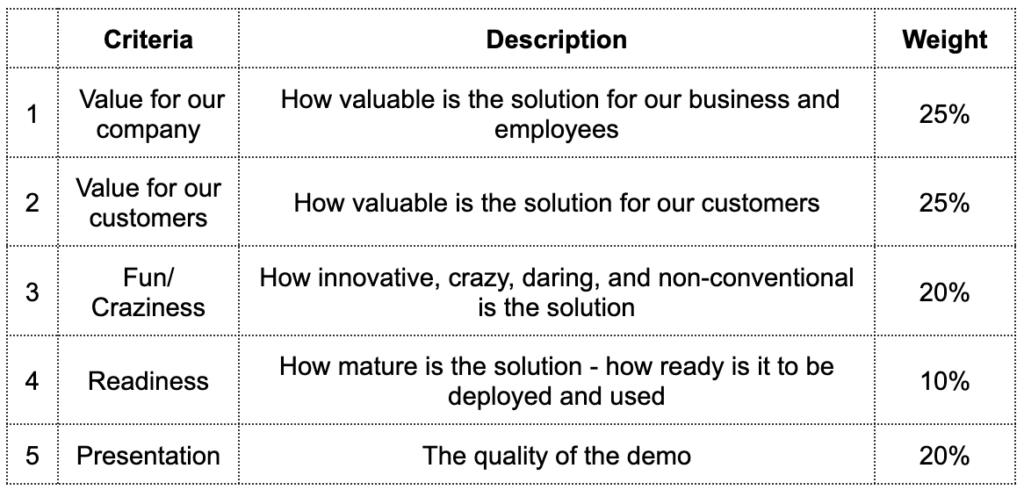
If there is competition – there should be prizes, right? That is correct! Prizes are essential – to give that extra drive, competitive angle, and recognition for hard work. If you google around – you’ll see that most hackathons use cash prizes (or Amazon vouchers) or go for some cool gadgets (e.g. VR glasses, drones, iPads, gaming consoles); however, besides being aware of the prize budget, it is also important to be aware of what is the company culture and what are the preferred prizes by the participants. For example, in our latest hackathon, we had extensive discussions about the prizes and we shifted mid-way from gadgets to experiences. All the hackathon teams got a budget for a team-organised experience of their choosing. Naturally, the 1st place got a much bigger (5x) prize than the prizes of the runner-up teams. Whatever prizes you choose – just make sure they are aligned with the expectations, desires, and values of your company and of course – fit in the prize budget.
Misc org aspects
If you think by now that there is just too much to do for a hackathon, think again. One is strong but many are stronger – you will need a hackathon org team. I recommend involving people who (1) can make financial decisions, (2) can help with organising all the practicalities, and (3) some potential participants. For example, we had the office managers, CEO, CPO, HR, and a senior engineer joining the org team. It’s a good mix because you can make decisions, keep the execution within the team and validate the decisions against the ‘end-users’. The org team will need to meet regularly to discuss the outstanding org topics. We had a 45-minute meeting every Friday (download a template for org team meetings) – and 10 meetings later we had a hackathon! It’s important to have an active chat for the org team and a running agenda. You, as a hackathon organiser, should keep track of the different org streams and the overall agenda, as well as prepare the agenda for each meeting – to make sure the primary topics are discussed and decisions made.
Hackathon, like everything else – needs documentation. I do recommend establishing a separate folder of pages in your collaborative documentation system (e.g. Confluence, Coda, or Notion) dedicated to the hackathon. Part of the pages will be public (e.g. general information about the hackathon, team creation page, idea submission page, and documentation pages for each team) and another part will be accessible only to the hackathon org team; document each meeting and maintain an up-to-date checklist of all the things pending (see my hackathon checklists here). You can see our hackathon page structure in the page tree example below. The green part is public – available to all employees and the red part is private – working space for the hackathon org team.
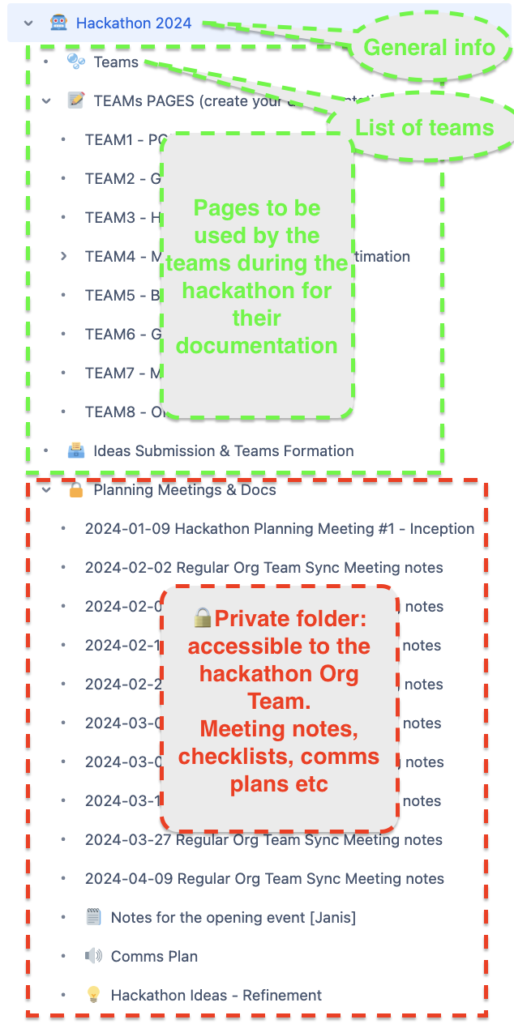
Here follows some other important aspects that your hackathon org team will have to plan for:
- Teams budget – can teams purchase something for their solution (e.g. hardware), what will be the allowance and reimbursement process?
- Facilities – each team will need a ‘home base’ for ~3 days – a room or part of a room where they can work uninterrupted with a good internet connection, comfortable furniture, and 24-hour access.
- Catering & snacks – will you provide lunches and dinners or reimburse the teams for ordering in (we mixed both)? How many snacks and soft drinks to order? Sugar and caffeine will be in high demand… From our experience, Coke Zero, Redbull, and beer run out the first…
- Leisure activities – what can teams do in between heavy working sessions to switch the context? Some games are always a good idea such as table tennis and foosball (we rented both).
- Merch – a hackathon deserves its own design and merch. At minimum have hackathon-branded t-shirts. But you may consider also posters, stickers, magnets, pens, notepads, etc.
- Music – during the opening events, between the pitches, and in between the demos it’s nice to fill in the silence (or buzz) with some background music – it feels professional and adds more smoothness to the transition time during events. Get a quality stereo system and practice quick play/pause moves with your phone/ Spotify.
- Continuity of the ideas – after the hackathon ensure some future for the ideas people worked on so hard. Discuss with product management which ideas should/ could be added to the roadmap or what is required for them to be considered for future implementation.
- Reflect and retrospect – as with any project – do a satisfaction survey for participants and a retrospective with the org team to understand what can be improved the next time (see my survey example here).
Hackathon is an amazing opportunity to break the routine, reshuffle the teams, and reignite the passion and innovation spirit in the company. While this guide might scare you – rest assured that the effort is 200% worth it! The team bonding, creativity, and fun of the hackathon is unparalleled. With solid planning (just use this guide!) and a strong, supportive org team you can prepare for a perfect hackathon and avoid any surprises!
Good luck with your hacking! 🙂
If you would like to download extra guidance and templates (‘Hackathon org pack’) for your next hackathon – click here!

